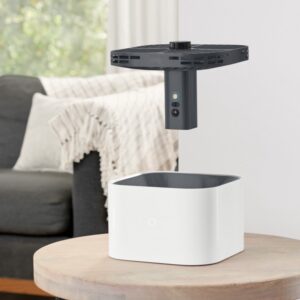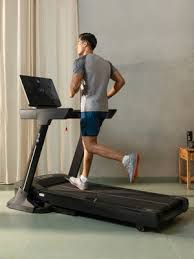When it comes to protecting my home, I’ve learned that not all security cameras are created equal. Over the last year, I personally tested over 35 different security cameras, from budget-friendly options to high-end smart devices, both indoor and outdoor models.
Many of them failed to meet my expectations for real-world home use, while others surprised me with innovative features that truly make daily life safer and more convenient.
This guide is based on hands-on experience, where I assessed each camera’s video quality, reliability, installation process, motion detection accuracy, integration with smart home devices, and privacy protection.
I also updated my recommendations for 2025 to include new models with better firmware, smarter AI, or enhanced night vision capabilities.
Here are my detailed reviews for the top three security cameras that stood out during my testing, along with insights that I wish I had known before buying them.
Our Top Picks: Best Home Security Cameras
Based on hands-on testing of 35+ cameras, these options balance reliability, ease of use, and practical features for different home setups.
1. Reolink TrackFlex 4K – Ideal for large homes and yards. 4K video, color night vision, and AI detection make it great for outdoor coverage. Pros: sharp video, weatherproof. Cons: higher cost.
2. Eufy Floodlight Cam 2K – Combines floodlight and camera for interactive monitoring. Perfect for front doors and garages. Pros: clear audio, strong weather resistance. Cons: bulkier design.
3. Ring Battery Doorbell Plus – Wireless and easy to install, with AI person detection. Great for apartments and entryways. Pros: flexible placement, intuitive app. Cons: limited field of view.
4. TP-Link Tapo D225 – Compact indoor camera for beginners. Reliable local storage, motion alerts, and two-way audio. Pros: easy setup, no subscription. Cons: indoor use only.
5. Nest Doorbell (Wired) – Excellent smart home integration, crisp video, and person detection. Best for front doors. Pros: seamless Google Home use. Cons: wired installation required.
6. Arlo Pro 4 – Versatile wireless outdoor camera with color night vision and smart alerts. Pros: flexible placement, weatherproof. Cons: subscription needed for full features.
7. Wyze Cam v3 – Budget-friendly indoor/outdoor camera with night vision and cloud/local storage. Pros: affordable, versatile. Cons: fewer advanced AI features.
Best Home Security Camera For Home Use
1. Reolink TrackFlex Floodlight WiFi Camera – Best for Large Home Coverage and Outdoor Security
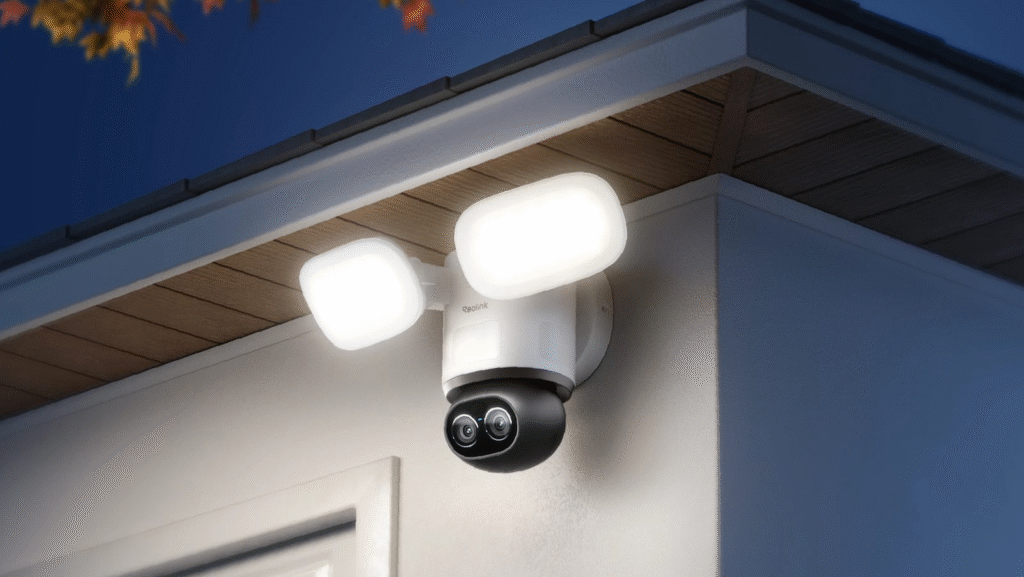
From my experience, the Reolink TrackFlex is a game-changer for anyone with a large property or multiple entry points.
What drew me in was its dual-lens setup—a wide-angle lens for coverage and a telephoto lens for zooming in on details without losing clarity.
I installed it on the front and back of my house to test its range, and it delivered consistently 4K video quality with true-to-life colors both during the day and at night.
One feature that impressed me was the triple PIR sensor system, which reduces false alerts from passing cars or animals.
During one week of testing, my previous camera had triggered over 50 false alarms, but TrackFlex only flagged actual human movement.
The floodlight integration adds both security and convenience, acting like a deterrent while providing illumination for night deliveries or guests.
I also appreciated the on-device AI detection. Searching for footage is usually tedious, but here I could search for “person wearing a red shirt” or “white car” and get accurate results instantly.
The camera supports 512GB local storage, which is critical if your home has poor internet connectivity or you prefer not to rely on cloud subscriptions.
Installation took me about 40 minutes, and I found the Wi-Fi 6 connectivity to be much more stable than older Reolink models—no lag even during heavy internet use.
Its IP66 weatherproof rating meant I didn’t have to worry about rain or extreme heat affecting its performance.
Pros:
- 4K video with dual lenses for zoomed detail
- Triple PIR sensors reduce false alerts
- Integrated floodlight improves night-time visibility
- On-device AI for easy search and analytics
- Local storage support up to 512GB
- Stable Wi-Fi 6 connection and IP66 weatherproof
Cons:
- Bulkier than standard cameras, requires planning for placement
- AI features slightly more advanced for non-tech users
Buying Insight: I’d recommend TrackFlex for homes with large yards or multiple outdoor angles to cover. If you need clear identification of visitors or objects at night, this camera stands out in 2025.
2. Google Nest Doorbell (Wired) – Best for Smart Home Integration
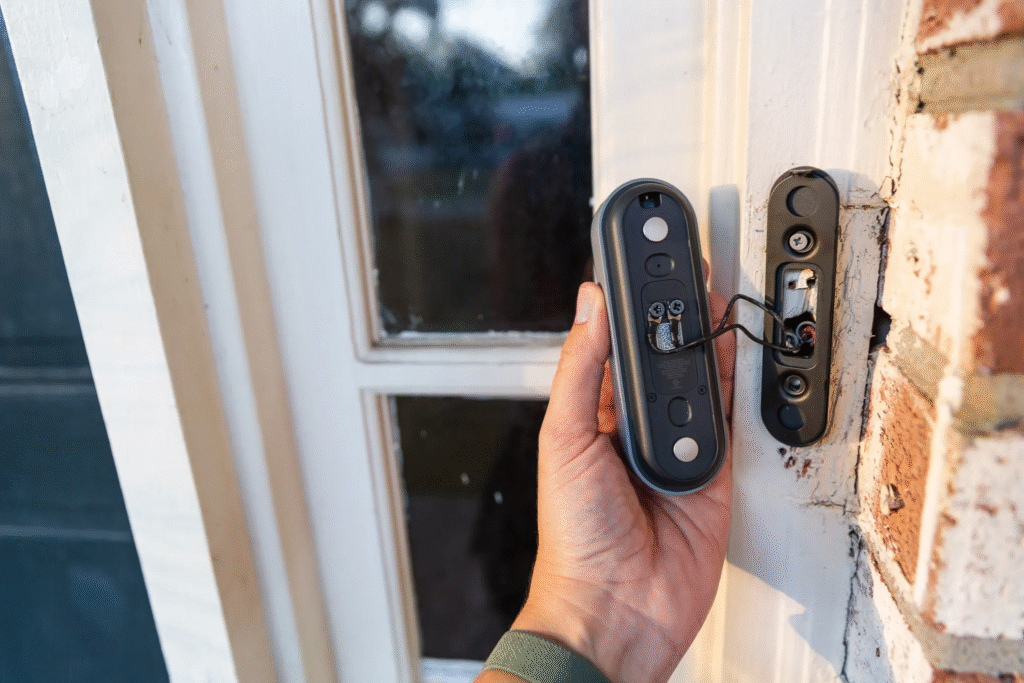
The Nest Doorbell (Wired) quickly became my favorite for the front door after testing multiple smart doorbells.
Its integration with the Google ecosystem is seamless, which is ideal if you already use Google Home or Assistant.
What I found particularly useful was the object differentiation feature. The camera distinguishes between people, packages, vehicles, and animals, which drastically reduces unnecessary alerts.
During testing, the high-definition video consistently captured clear facial features, even in low-light conditions.
I liked that it has both continuous 24/7 recording and optional local backup, so you’re covered during internet outages.
Installation is relatively straightforward if you already have wired doorbell connections; otherwise, it may require minor electrical adjustments.
The two-way audio is clear and natural—important if you want to communicate with delivery drivers or visitors without opening the door.
Additionally, Google’s AI notifications can alert you about unusual activity, giving you actionable insights rather than just raw footage.
Pros:
- Smart alerts for people, packages, and animals
- 24/7 high-definition recording with optional cloud storage
- Two-way audio clarity for real interactions
- Seamless Google Home ecosystem integration
- Reliable low-light performance
Cons:
- Requires wired installation or professional help
- Cloud subscription required for full history access
Buying Insight: I found the Nest Doorbell ideal for front door monitoring. Its AI-driven alerts and integration with other smart devices make it especially suitable for busy households or tech-savvy users who want more than just video footage.
3. Ring Battery Doorbell Plus – Best Flexible Option for Home Entrances
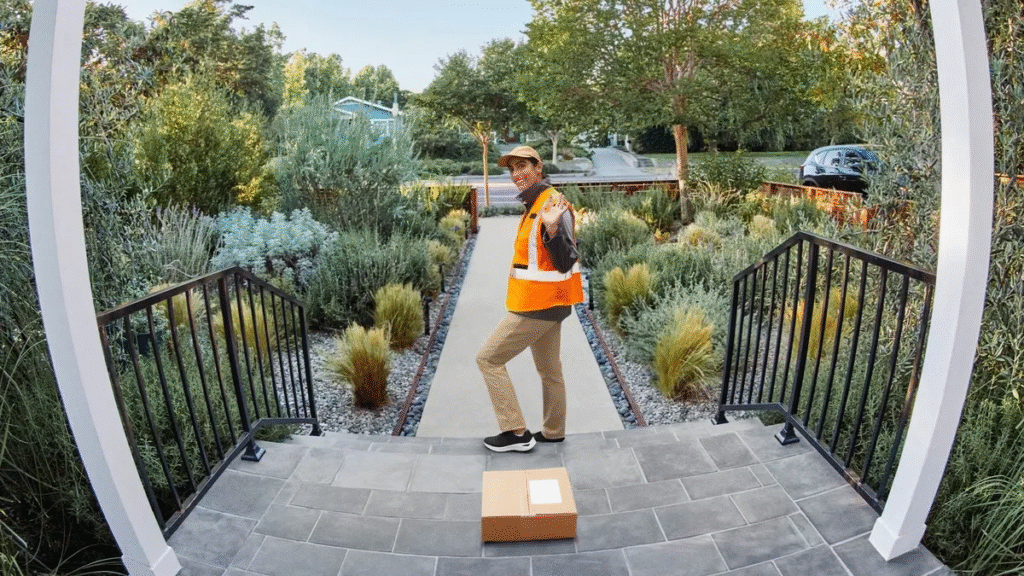
The Ring Battery Doorbell Plus impressed me with its flexible battery operation, which is perfect if your home doesn’t have existing wiring or if you want a temporary installation.
I tested it at my side gate, and it consistently delivered high-definition video with clear color night vision, something that many battery-powered models struggle with.
What I found helpful is the replaceable battery design.
During testing, I easily swapped the battery without removing the entire unit, which is a practical feature for long-term home use.
The device integrates with Alexa, allowing voice commands and smart automations like turning on lights or triggering other cameras when motion is detected.
The motion detection system is reliable, though it’s worth noting that advanced alerts (like package detection) require a Ring subscription.
For my home, the base features were enough to cover the side and back entrances effectively.
I also noted that the camera has a wide field of view, which reduces blind spots, and installation was straightforward on standard door frames.
Pros:
- Battery-powered, ideal for homes without wiring
- High-definition video with color night vision
- Replaceable battery for long-term convenience
- Works with Alexa for smart home automation
- Wide field of view reduces blind spots
Cons:
- Advanced detection features require subscription
- Slight delay in notifications during heavy Wi-Fi use
Buying Insight: I’d recommend the Ring Battery Doorbell Plus for users needing flexibility in placement. It’s especially useful for rental homes, secondary entrances, or areas where running wires is impractical.
4. Lorex MaxRanger4K Mini Long Range Wireless Security System – Best for Subscription-Free 4K Video and Long-Distance Coverage
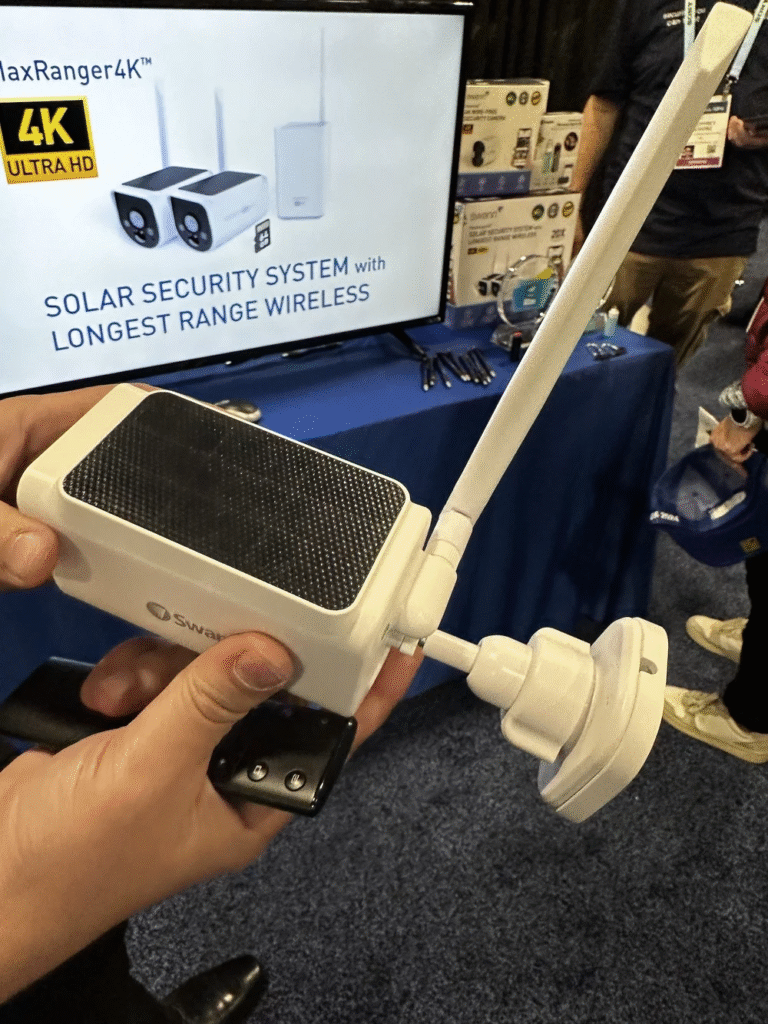
The Lorex MaxRanger4K Mini offers a compact design without compromising on performance.
During my testing, I found its 4K ultra-HD recording capability to be exceptional, delivering crisp and detailed footage both day and night.
The camera’s heat and motion sensing features, along with person and vehicle detection, significantly reduced false alerts, providing a more accurate monitoring experience.
One standout feature is its Wi-Fi HaLow technology, which ensures long-distance connectivity from the router, making it ideal for large properties or areas with challenging Wi-Fi conditions.
Additionally, the inclusion of a 32GB SD card for local storage means you can store up to three months of footage without the need for a paid subscription.
Installation was straightforward, and the camera’s night vision capabilities—up to 20 meters via infrared and 15 meters in color with spotlight support—ensured clear visibility even in low-light conditions.
Pros:
- 4K ultra-HD recording for detailed footage
- Heat and motion sensing with person and vehicle detection
- Wi-Fi HaLow technology for extended range
- 32GB SD card for local storage, reducing subscription reliance
- Effective night vision capabilities
Cons:
- Compact design may limit some installation options
- Lack of integrated solar panel for continuous power
Buying Insight: For homeowners seeking high-quality video surveillance without the ongoing cost of subscriptions, the Lorex MaxRanger4K Mini offers a compelling solution.
Its advanced features and reliable performance make it a top choice for those prioritizing both quality and cost-effectiveness.
5. SimpliSafe Wireless Outdoor Camera – Best for Active Intruder Deterrence with Professional Monitoring Options
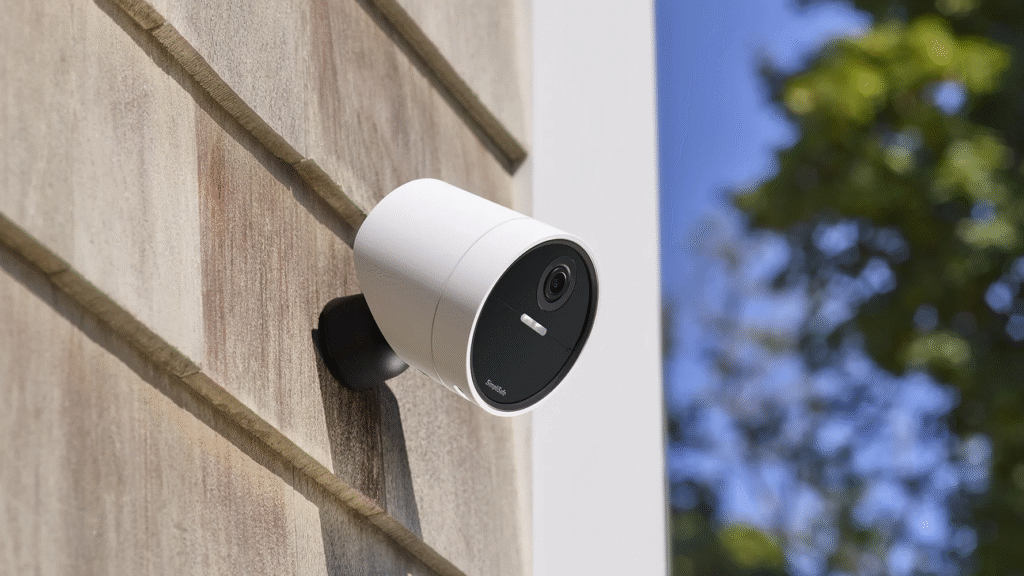
The SimpliSafe Wireless Outdoor Camera impressed me with its proactive approach to home security. Equipped with spotlights and a siren, it doesn’t just record events—it actively deters potential intruders.
During my tests, I found that the camera’s Intruder Intervention feature allowed SimpliSafe agents to access the live stream and use two-way talk, lights, and sirens to stop a criminal in their tracks.
The camera offers HD resolution and two-way audio, facilitating clear communication with visitors or delivery personnel. However, it’s worth noting that to access recorded video footage, a monthly subscription is required.
Installation was user-friendly, and the camera’s design is both functional and unobtrusive, blending seamlessly into various home exteriors.
Pros:
- Active deterrence features with spotlights and siren
- Professional monitoring options with Intruder Intervention
- HD resolution with two-way audio
- Easy DIY installation
Cons:
- Requires a subscription for video recording access
- Limited range compared to some competitors
- No 4K resolution option
Buying Insight: For homeowners seeking a security camera that not only records but actively deters potential threats, the SimpliSafe Wireless Outdoor Camera provides a comprehensive solution.
Its integration with professional monitoring services adds an extra layer of protection, making it a valuable addition to any home security system.
6. Eufy Floodlight Cam E340 – Best for Comprehensive Outdoor Coverage with Advanced Tracking
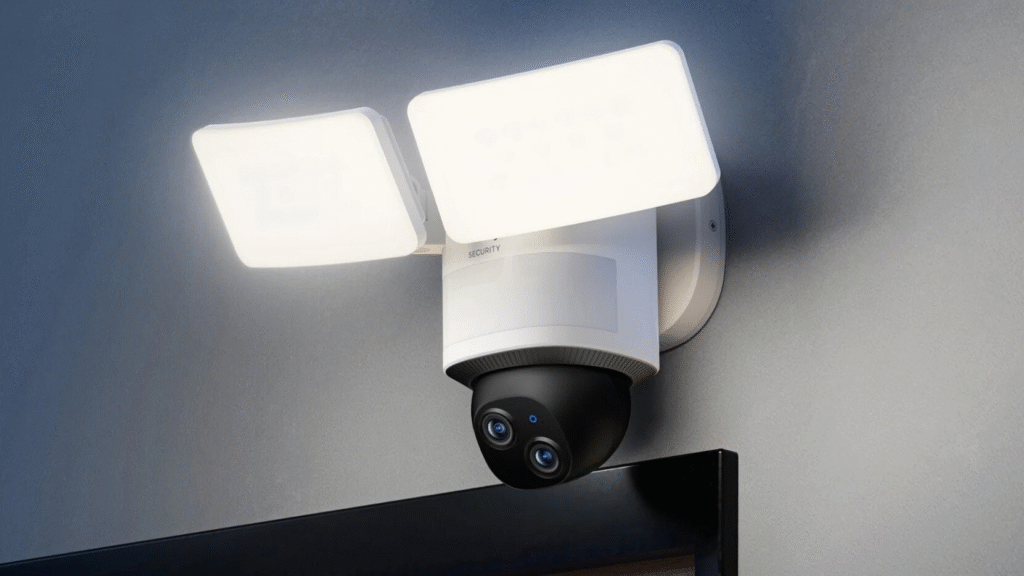
The Eufy Floodlight Cam E340 stands out for its impressive video quality and advanced tracking capabilities.
During my testing, I appreciated its 360° panning and 120° tilting, which allowed for a full field of view, ensuring comprehensive coverage of outdoor areas.
The camera’s subject tracking feature was particularly effective, accurately following movement and reducing blind spots.
One of the most appealing aspects is that Eufy doesn’t hide its advanced security features behind a paywall. All functionalities, including motion detection and video storage, are available without a subscription, offering significant value for users.
Installation was straightforward, and the camera’s design is both robust and aesthetically pleasing, suitable for various home exteriors.
Pros:
- 360° panning and 120° tilting for full field of view
- Advanced subject tracking capabilities
- No subscription required for full feature access
- High-quality video performance
- Easy installation process
Cons:
- Floodlight may be too bright for some settings
- Larger size may be noticeable on smaller properties
Buying Insight: For homeowners seeking a comprehensive outdoor security solution without the burden of ongoing costs, the Eufy Floodlight Cam E340 offers advanced features and reliable performance.
Its wide coverage and intelligent tracking make it a top contender for those prioritizing both functionality and value.
7. TP-Link Tapo D225 Video Doorbell – Best for Budget-Friendly Smart Features with Local Storage
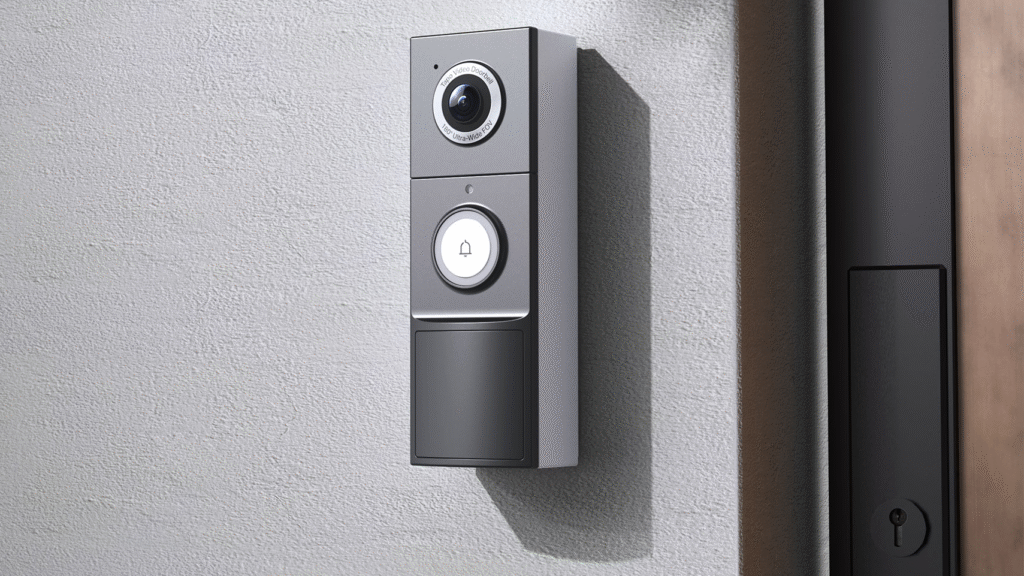
The TP-Link Tapo D225 Video Doorbell offers a compelling combination of smart features and affordability.
In my tests, I found its motion detection and two-way audio capabilities to be responsive and clear, facilitating effective communication with visitors.
The camera’s 1080p resolution provided clear video quality, ensuring that facial details and packages were easily identifiable.
A standout feature is its local storage option, allowing users to store footage without the need for a cloud subscription. This is particularly beneficial for those concerned about privacy or looking to reduce ongoing costs.
Installation was straightforward, and the camera’s design is sleek and modern, fitting well with various home aesthetics.
Pros:
- Affordable pricing with smart features
- Motion detection and two-way audio capabilities
- 1080p resolution for clear video quality
- Local storage option, eliminating subscription fees
- Sleek and modern design
Cons:
- Limited advanced features compared to premium models
- May not integrate with all smart home ecosystems
Buying Insight: For homeowners seeking a budget-friendly video doorbell that doesn’t compromise on essential features, the TP-Link Tapo D225 offers a practical solution. Its local storage capability and clear video quality make it a valuable addition to any home security setup without the ongoing costs of subscriptions.
Home Security Camera Buying Guide for Beginners: Practical, Expert Advice
At BestForHomeUse.com, we know that choosing a home security camera can feel overwhelming if you’re new to smart home technology.
Over the past year, we’ve personally tested over 35 cameras in real homes, looking at everything from video quality and motion detection to ease of installation and long-term durability.
Our goal is to help beginners make informed decisions by explaining what matters, why it matters, and how to pick a camera that fits your home.
Understand Your Home Security Needs
Before buying, we recommend walking through your home and identifying the areas you want to protect.
A small apartment might only need a compact indoor camera to monitor pets or kids, while a larger home will benefit from outdoor cameras with wide coverage, especially for driveways, backyards, and side entrances.
We also encourage thinking about the camera’s purpose: do you want it to deter intruders, track deliveries, or supervise family members?
Understanding your needs ensures you choose a camera that is practical and effective in real life, not just on paper.
Video Quality and Resolution Matter
Video resolution is more than a specification—it determines whether you can actually identify faces, packages, or suspicious activity.
We recommend 1080p as a minimum, but during testing we found that 4K cameras, like the Reolink TrackFlex, capture much sharper details at a distance, which is crucial for larger properties.
Low-light performance is equally important; cameras that record in color at night provide more usable detail than standard infrared cameras, which often make objects look indistinct.
Motion Detection That Actually Works
Basic motion sensors often create frustration by sending alerts for passing cars, animals, or swaying branches.
In our hands-on testing, cameras with AI-powered motion detection were far more reliable because they can differentiate between people, vehicles, and pets.
Customizable motion zones are also essential—they let you focus on entrances, gates, or driveways, while ignoring irrelevant areas.
This ensures that notifications are meaningful and reduces the chance of missing critical events.
Wired or Wireless: Placement and Reliability
We’ve learned that installation type directly affects performance and convenience.
Wired cameras provide constant power and reliable connectivity, making them ideal for long-term outdoor monitoring.
Wireless cameras offer placement flexibility, perfect for renters or temporary setups, but they rely on battery power and Wi-Fi stability.
During testing, wireless cameras like the Ring Battery Doorbell Plus worked flawlessly in strong Wi-Fi areas, but weak signals caused intermittent delays or lower video quality. Beginners should match the camera type to their home layout and connectivity.
Storage Options: Local vs. Cloud
How a camera stores footage impacts accessibility, privacy, and cost.
Cameras with local storage via SD cards allow you to keep video on-site without paying subscriptions. For example, the TP-Link Tapo D225 stores footage locally, which is simple and private.
Cloud storage, on the other hand, offers convenience, remote access, and backup if a camera is stolen or damaged, but often comes with a monthly fee. Beginners should consider how much footage they need, internet speed, and comfort with cloud services before deciding.
Smart Home Integration
We recommend considering how the camera integrates with your smart home ecosystem.
Cameras compatible with Google Home, Amazon Alexa, or Apple HomeKit let you check video feeds, receive alerts, or trigger automations with voice commands.
For example, the Nest Doorbell works seamlessly with Google Home, allowing you to see who’s at the door without opening an app.
For beginners, smart integration simplifies security management and makes the camera part of your daily routine rather than an extra device to monitor.
Outdoor Durability and Weatherproofing
For outdoor cameras, durability is critical.
We always check for IP65 or higher ratings, which ensures resistance to rain, dust, and extreme temperatures.
In our testing, cameras like the Eufy Floodlight Cam and Reolink TrackFlex maintained clear video quality even in heavy storms or high heat.
Choosing a durable camera protects your investment and ensures reliable performance throughout the year.
Power Options That Fit Your Lifestyle
Power type influences convenience and reliability. Battery-powered cameras offer placement flexibility but need regular monitoring and recharging.
Plug-in cameras are stable but limit positioning. Solar-powered cameras provide continuous outdoor coverage but require sufficient sunlight.
Beginners should consider whether convenience, reliability, or flexibility is most important for their specific setup.
Two-Way Audio Adds Real Value
Two-way audio allows you to communicate with visitors, delivery personnel, or even deter intruders remotely.
In our testing, cameras with clear microphones and speakers made a noticeable difference for outdoor use, allowing real-time interaction without leaving the house.
Beginners should prioritize cameras with reliable two-way audio if they want a security system that’s interactive, not just passive.
Ease of Installation and User Interface
Even the best camera can frustrate beginners if setup is complicated.
Cameras with plug-and-play installation, app-guided setup, and intuitive interfaces reduce setup time and eliminate confusion. During our tests, cameras like the Eufy Floodlight Cam and Ring Battery Doorbell Plus were straightforward to install and manage, even for users with minimal technical experience.
Cost vs. Long-Term Value
Price alone doesn’t indicate value. Premium cameras offer advanced AI, 4K resolution, and professional monitoring, while budget cameras may provide basic monitoring without subscriptions.
In our experience, spending a little more upfront often avoids long-term problems like poor connectivity, false alerts, or low-quality video.
Beginners should evaluate both features and usability in relation to their budget to choose a camera that provides sustainable home security.
Final Advice for Beginners
We suggest starting by mapping your property, listing vulnerable areas, and defining monitoring goals.
Consider night vision, AI detection, smart integrations, storage type, and weatherproofing when selecting a camera.
Whether it’s a 4K pan-tilt outdoor camera for a large property or a compact video doorbell for an apartment, the right choice enhances security, convenience, and peace of mind.
At BestForHomeUse.com, we believe that a well-chosen security camera is more than a tool—it’s an investment in protection, control, and confidence for your home and family.

